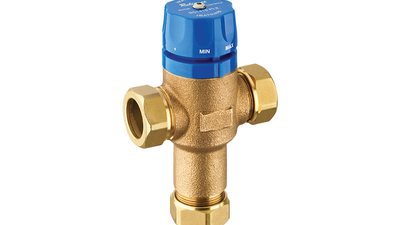Enhancing the safety of pressurised hot water cylinders

With the nation still battling the COVID-19 pandemic and people advised to spend as much time as possible at home, it’s more important than ever to ensure water is supplied safely around our households. To avoid unnecessary visits to hospitals and ease the pressure on our already overstretched healthcare system, a number of safety measures can be taken to minimise the risk of accidents, injuries and the spread of diseases. One such area that needs to be looked at is pressurised hot water cylinders and solutions to enhance their safety.
Pressurised hot water cylinders, otherwise known as unvented hot water cylinders, have become more popular over the years, thanks to a trend towards multi-generational living and multi-bathroom households that require water at consistently high pressure at all outlets. As the popularity of these systems increases, we explore the key benefits and safety aspects that every installer should be aware of, as well as the vital role tempering valves play in preventing scalding.
What’s the appeal of pressurised hot water systems?
Going right back to basics, the main difference between a vented and unvented system lies in the way each cylinder is supplied with water. Vented hot water cylinders are gravity fed, from a cold water cistern tank which is located in the loft, to a cylinder stored below in an airing cupboard. Whereas an unvented system is connected directly to the water mains and offers a number of benefits:
- Hot water on demand: Hot water at mains pressure is constantly supplied to multiple outlets, regardless of the frequency or level of demand.
- Space-saving solution: Being connected to water mains means there is no need for a cold water tank in the loft, therefore, the space can be used for additional storage or future renovation projects.
- More energy efficient: Unvented hot water storage cylinders have proven to be energy efficient which is why they are better for the environment and your customers’ pockets.
- Less technical issues: There is no need for a cistern tank, eliminating the risk of float valve jams, blockages in the pipework or cistern water freezing.
Understanding the safety features of pressurised cylinders
As the name suggests, this type of hot water system works under extreme pressure. To ensure a safe and stable supply of hot water, pressurised cylinders are additionally fitted with expansion vessels which enable the cylinder to operate at a safe pressure level.
In addition to the expansion vessel, cylinders are fitted with other failsafe mechanisms too. These include pressure relief valves and thermal relief valves, which are designed to open and close the water supply if the system exceeds the preset temperature or pressure level.

Why is on-going maintenance of unvented hot water cylinders important?
While these safety measures will protect the cylinder from exceeding its maximum operating parameters, failing to carry out a regular service can lead to high temperatures and pressure build-up in the system long before relief valves are triggered. As a result, occupants can experience pressure spikes and splash-backs, which can cause scalding if the pipework contains water at high temperatures.
To reduce the risk of pressure spikes and scalding, unvented cylinders must be serviced annually to stay compliant with building regulations. However, not all homeowners and landlords are aware of this or comply with these requirements. So as an installer, it’s our duty of care to make them aware of the possible risks and help prevent any accidents or injuries.

Tempering valves, a safety failsafe
Although we cannot guarantee that homeowners and landlords will adhere to regular servicing guidelines, we can further reduce the risk of scalding by installing a tempering valve along with the cylinder.
Tempering valves, such as the Heatguard Tempering Valve from Reliance Valves, are fitted to the hot water outlet of the pressurised cylinder and the cold water mains to regulate the outlet temperature. Any excessively hot water leaving the cylinder is blended back down to a safe and stable operating temperature, minimising the chances of scalding.

A simple way to offer improved safety to customers
Installing a tempering valve takes minimal time and the Heatguard Tempering Valve comes complete with 22mm compression connections, making installation quick and easy. Although not required by law, it is good practice to recommend tempering valves as an additional layer of safety for occupants.
Not only do tempering valves offer peace of mind, they can also contribute to building a reputation as a quality tradesperson who puts customer safety at the heart of their business.
In these unprecedented times, we’re with you all the way to help navigate through the rough waters and ensure that a safe plumbing and heating system is one less thing to worry about for both you and your customers.
For the problem solvers, the urgent fixers, the everyday heroes and the truly up against it, we’re with you all the way.
Discover more
Check out our full range of reliable thermostatic mixing valves for optimal safety and comfort.
